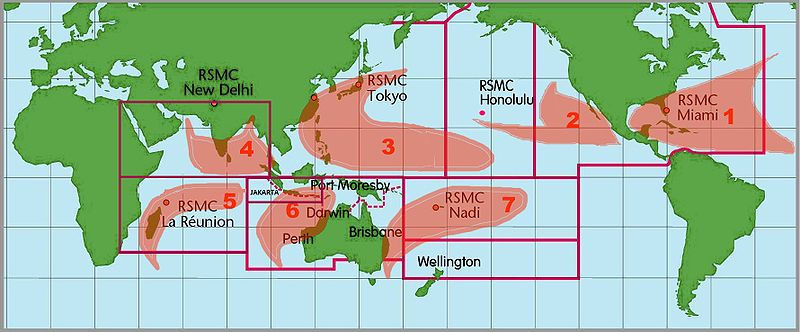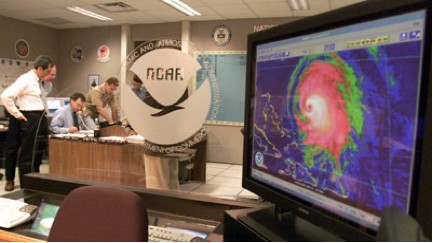
Locations of the RSMCs and TCWCs and their ocean basins of forecast responsibility. NOAA’s National Hurricane Center (RSMC Miami) is responsible for both the North Atlantic basin (region 1) and the part of the Northeast Pacific basin from the west coast of North America to 140°W longitude (eastern part of region 2). NOAA’s Central Pacific Hurricane Center (RSMC Honolulu) is responsible for the rest of the Northeast Pacific from 140°W to 180° longitude, also sometimes referred to as the North Central Pacific basin (western part of region 2). The Japan Meteorological Agency (RSMC Tokyo) is officially responsible for the Northwest Pacific basin (region 3), but forecast duties are shared by China, Thailand, Korea, Japan, and the Philippines. The Indian Meteorological Department (RSMC New Delhi) is officially responsible for the North Indian basin (region 4), but forecast duties are shared by India, Thailand, Pakistan, Bangladesh, Burma, and Sri Lanka. Meteo-France (RSMC La Reunion) is officially responsible for the Southwest Indian basin (region 5) but forecast duties are shared by Reunion Island, Madagascar, Mozambique, Mauritius, and Kenya. TCWCs within the Australian Bureau of Meteorology (Perth and Darwin) and the Meteorology and Geophysical Agency of Indonesia share responsibility for the Southeast Indian basin, including many seas and gulfs near Australia (region 6). TCWCs within the Australian Bureau of Meteorology (Brisbane), the Meteorological Service of New Zealand (Wellington), and the Papua New Guinea National Weather Service (Port Moresby), as well as the Fiji Meteorological Service (RSMC Nadi) share responsibility for the South Pacific basin (region 7 and eastern part of region 6). Image credit: NOAA/AOML.



